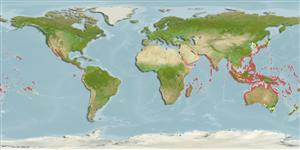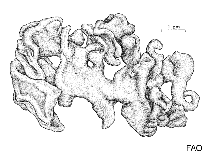Codium arabicum Kützing
Green sea cushion| Native range | All suitable habitat | Point map | Year 2050 |

|
| This map was computer-generated and has not yet been reviewed. |
| Codium arabicum AquaMaps Data sources: GBIF OBIS |
Upload your photos
Google image | No image available for this species;
drawing shows typical species in Codiaceae.
Google image | No image available for this species;
drawing shows typical species in Codiaceae.
Classification / Names Common names | Synonyms | CoL | ITIS | WoRMS
Bryopsidophyceae | Bryopsidales | Codiaceae
Environment: milieu / climate zone / depth range / distribution range Ecology
Epiphytic. Tropical
Distribution Countries | FAO areas | Ecosystems | Occurrences | Introductions
Indian Ocean: from Egypt to Mozambique, including the Red Sea, Seychelles, Madagascar, Mauritius, Réunion, Rodrigues and Mascarene Islands, east to India and south to Dampier, Western Australia, including Andaman Sea, Laccadive Islands, Maldives, Sri Lanka and Nicobar Islands; Pacific Ocean: from China to the south China Sea, south to New Zealand, including Federated States of Micronesia, Fiji, Norfolk Islands, the Great Barrier Reef, Lord Howe Island, Tasmania and French Polynesia, east to Chile, including Samoan Archipelago and Hawaiian Islands.
Length at first maturity / Size / Weight / Age
Maturity: Lm ? range ? - ? cm
Short description Morphology
Thallus forming a dark green, amorphous to convoluted spongy mass, composed of central medulla and cortex. Medulla consisting of branched cylindrical filaments, their tips inflated into cylindrical to clavate utricles forming the cortex.Hairs or hair scars occur in 1 to 3 vertical rows, at some distance from the tip of the utricle. Gametangia cylindrical and tapering towards both ends, borne at the side of the proximal portion of the utricle. Amorphous clumps up to 5 cm in diameter (Ref. 80758).
Used for human consumption and as medicine (Ref. 80758). Inhabits lower intertidal to shallow subtidal areas where it grows encrusted on sandy-rocky substrate or epiphytic on stipes of larger seaweeds and midribs of the seagrass Enhalus (Ref. 80758).
Life cycle and mating behavior Maturity | Reproduction | Spawning | Eggs | Fecundity | Larvae
Main reference
References | Coordinator | Collaborators
Guiry, M.D. and G.M. Guiry. 2009. (Ref. 80701)
IUCN Red List Status (Ref. 130435)
CITES status (Ref. 108899)
Not Evaluated
CMS (Ref. 116361)
Not Evaluated
Threat to humans
Harmless (Ref. 80758)
Human uses
Fisheries: commercial
| FishSource |
Tools
More information
Internet sources
BHL | BOLD Systems | CISTI | DiscoverLife | FAO(Publication : search) | Fishipedia | GenBank (genome, nucleotide) | GloBI | Gomexsi | Google Books | Google Scholar | Google | PubMed | AlgaeBase | Tree of Life | Wikipedia (Go, Search) | Zoological Record
Estimates based on models
Preferred temperature
(Ref. 115969): 24.6 - 29.3, mean 28.4 (based on 2952 cells).



